Table of contents
- Second-hand advice: Misunderstood motorcycles Used bikes that nobody wants
- BMW F 650 CS
- Buell Ulysses XB12X
- Ducati Multistrada 620
- Harley-Davidson Street Rod
- Honda X-Eleven
- Kawasaki 1000 GTR
- MZ Baghira
- Suzuki XF 650 Freewind
- Triumph TT 600
- Yamaha MT-03
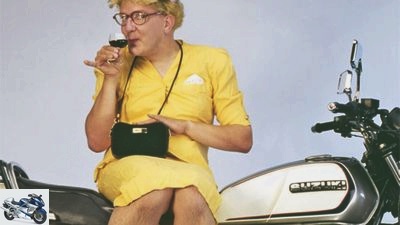
fact
counselor
Used purchase
Second-hand advice: Misunderstood motorcycles
Second-hand advice: Misunderstood motorcycles
Used bikes that nobody wants
She has a great personality and is a nice, reliable guy. But still she just can’t find a partner. What might that be?? An attempt at analysis.
Klaus Herder
11/14/2011
Appearance is not everything. But – to put it cautiously – an appearance that takes getting used to does not make selling anything any easier. This is about sales. First of all, about new sales, without which, of course, the later used business would not function either. The ten models featured in this article were all new sales flops in their active days. What some manufacturers would confirm immediately (e.g. Harley-Davidson), but others vehemently deny it on principle (BMW) or put it into perspective (e.g. Kawasaki, because the 1000 GTR was sold quite well in the USA). Your failure in Germany has various reasons, also in combination. For example, messed up packaging and the wrong target group (BMW, Buell and Harley), wrong displacement class (Ducati) or a target group that does not exist at all (Honda and Yamaha).
Buy complete article
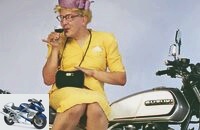
Second-hand advice: Misunderstood motorcycles
Used bikes that nobody wants
4 pages) as PDF
€ 2.00
Buy now
Sometimes it is enough to flop if you move into categories that are already well occupied by the competition (Kawasaki, Suzuki and Triumph). Appearing with the wrong name and engine at the wrong time is also not very sales-promoting (MZ). Our ten used buying tips may not be bestsellers, but that doesn’t mean they are exotic species that are difficult to find. A real plus point for potential buyers: The previous relationship was often their first with the wallflowers. Well-kept specimens with only one previous owner are to be found above average in this field; because anyone who has indulged in such a treasure must have acted out of real and very great love.
BMW F 650 CS

archive
BMW F 650 CS.
There is probably no other motorcycle in which the intended target group and the actual buyer base were as far apart as the “Scarver”, which was built from 2002 to the end of 2005. The single was advertised as a trendy fun device for hip, chic young people. It was bought – if at all – by seasoned BMW customers who wanted to say goodbye to the boxer or K model in the old days and were looking for something smaller and lighter. Customers who were slightly shorter were also among the customers, because of all the F-series models, the CS offered the lowest seat height. A few nice gimmicks make the CS unique: where other motorcycles have a tank, the CS has a multifunctional storage compartment, for example for a sound system, but in practice more for a luggage bag. Single-sided swing arm, toothed belt and fat road rubbers also make the CS unique in the BMW single environment. Used from 2500 euros.
plus
- Fuel consumption sensationally low
- Beefy and elastic engine
- Low-maintenance final drive (belt)
- ABS controls very sensitively (but is extra)
- Lush range of equipment / accessories
minus
- Engine vibrations are quite rough and annoying in the upper speed range
- Chassis weaknesses: moderate accuracy and wobble in tight corners
- Suspension strut overwhelmed in pillion mode
Data
Water-cooled single-cylinder four-stroke engine, 652 cm³, 37 kW (50 PS) at 6500 rpm, weight 193 kg, load 177 kg, tank capacity 15 liters, seat height 770 mm, top speed 180 km / h, consumption (country road) 3.6 l / 100 km, normal
Buell Ulysses XB12X
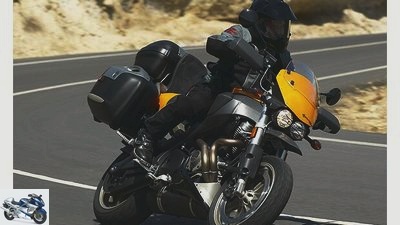
Buell
Buell Ulysses XB12X.
Whoever has a GS from BMW in the shortlisted second-hand purchase does not need to worry about the Ulysses, which was built from 2006. Reisemotorrad-Kon can be more different-
not be recipes. But the other way round it turns into a shoe: an ancient engine concept in a hyper-modern frame that serves as a tank and carries a swing arm that stores the engine oil. In addition, an ultra-handy chassis design that cannot take into account such mundane things as straight-line stability – only the American iron offers such a crazy combination and alternative to the common GS. The wonderfully crazy high seat cannot be measured with normal standards, there is actually no reasonable reason to treat yourself to this mix of enduro, supermoto and racer. Yes, there is: The last copies of the brand, which was buried at the end of 2009 and which is already cult, were sold brand new for well under 9,000 euros. Young, good used ones are available from 6000 euros – and there are none.
plus
- Harley engine surprisingly agile in the upper speed range and low in vibration
- Ergonomics for driver and pillion successful
- Toothed belt drive requires little maintenance
- Excellent handiness, little mass
minus
- Straight-line stability absolutely unsatisfactory
- The brake requires a lot of manual force and is not particularly finely dosed
- Gear shifting gnarly and loudly
- Equipment sparse, ABS not available
Data
Air-cooled two-cylinder four-stroke V-engine, 1203 cm³, 75 kW (101 hp) at 6600 rpm, weight 228 kg, payload 203 kg, tank capacity / reserve 16.7 / 3.1 liters, seat height 885 mm, top speed 219 km / h, consumption (country road) 4.9 l / 100 km, super plus
Ducati Multistrada 620
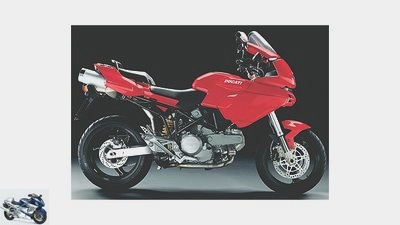
Ducati Multistrada 620.
It is often not easy for little sisters. The 620 Multistrada was always overshadowed by its new machine, which was 2900 euros more expensive, but also 29 hp more powerful 1000 sister. 13 kilos less combat weight, more wind protection, a better tuned chassis and crisper handling – none of that helped. The small Multistrada was sold as a new machine in homeopathic doses and was only in the range in 2005 and 2006. Their somewhat jellyfish design, which the big sister also struggled with, didn’t make things any easier. It was just the time of the Ducati design aberrations, just think of the infamous 999. It doesn’t matter who took a seat on the 620, you don’t have to see the misery and can look forward to a lot of country road fun. Small streets with many alternating curves, also with a slightly wavy surface, are the preferred area of the comfortably tuned planer, which is available as a used machine from 3800 euros.
plus
- Engine set-up successful all round, crisp throttle response, great sound
- Handiness very pronounced
- Wind protection suitable for long distances
- Upright and relaxed sitting position
minus
- Fuel consumption far too high
- Seat upholstered too soft
- Front brake difficult to dose in the limit area
- Modest payload
Data
Air-cooled two-cylinder four-stroke V-engine, 618 cm³, 46 kW (63 PS) at 9500 rpm, weight 207 kg, load 183 kg, tank capacity 15 liters, seat height 835 mm, top speed 185 km / h, consumption (country road) 6 , 5 l / 100 km, super
Harley-Davidson Street Rod

Jahn
Harley-Davidson Street Rod.
Even seasoned industry experts usually have to think a little longer in order to have a specific motorcycle in front of them when it comes to street rod. The V-Rod offshoot, built as a street athlete from 2005 to 2007, has practically completely disappeared from the collective motorcycle consciousness. At least technically, Harley had done everything right. The already potent Revolution engine got three more
PS packed on it and convinced with perfect power delivery. The chassis and brakes were new and matched the dynamic pace perfectly. There was nothing to complain about when it came to the seating position and the freedom of inclination. And yet the Street Rod became THE Harley flop. No wonder, because packaging plays an important role with Ami-Eisen, even more than with other brands. And the Street Rod design is just plain uninspired, boring, far too much of a cruiser and a total grip on the toilet. The upcoming cult is on offer from 8500 euros.
plus
- Driving performance not only impressive for Harley standards
- Brakes extremely gripping
- Comfortable touring position
- Exhaust and notches tilt-friendly
minus
- Instruments difficult to read
- Coupling requires a lot of manual force
- Rearview mirrors only have an alibi function
- Passenger suitability below average
- Side stand not very trustworthy
Data
Water-cooled two-cylinder four-stroke V-engine, 1131 cm³, 88 kW (120 PS) at 8250 / min, weight 292 kg, payload 172 kg, tank capacity 18.9 liters, seat height 803 mm, top speed 217 km / h, consumption (country road ) 5.9 l / 100 km, super
Honda X-Eleven
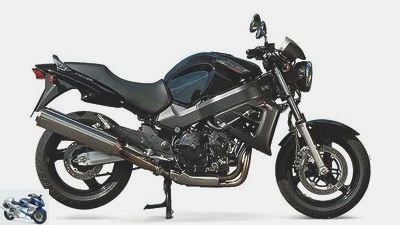
archive
Honda X-Eleven.
Actually, it’s a good thing not to do it like everyone else. So not to put an air-cooled row quad in a classic tubular steel frame and mount two struts. Nothing retro, modern technology without cooling fins, but with a large water cooler and a central spring strut in the light metal framework. On top of that, injection, G-Kat, composite braking system and a little design gimmick on the teardrop-shaped cockpit and the snowplow-like radiator cowling. Everything very independent, everything very laudable – but unfortunately almost not for sale. Because when it comes to large-capacity naked people, the customer wants a retro look. That was already the case at the X-Eleven premiere in 1999. And nothing changed until the last year of construction in 2003. If you are still the most unwieldy and expensive, even an extremely powerful engine is of little help. A used temptation from 3000 euros is definitely the stunner.
plus
- Strong and stable engine enables very good driving performance
- Impeccable workmanship
- Inspection costs are relatively cheap in a class comparison
minus
- Spring elements hardly adjustable (only rear spring base)
- Manageability severely restricted due to the rear-heaviness, especially with a pillion passenger
- Compound brake cannot be optimally metered
Data
Water-cooled four-cylinder four-stroke in-line engine, 1137 cm³, 100 kW (136 PS) at 9000 / min, weight 257 kg, payload 185 kg, tank capacity / reserve 22/4 liters, seat height 790 mm, top speed 251 km / h, consumption (country road ) 6.4 l / 100 km, normal
Kawasaki 1000 GTR

Kawasaki 1000 GTR
Kawasaki 1000 GTR.
The Americans love the GTR, which they call Concours. In the United States, people appreciate cozy comfort with the best wind and weather protection as well as complete equipment. Chassis qualities? More of secondary importance over there, but definitely an issue in old Europe. In 1986, the first year of its debut, testers complained about the fork which was far too soft and the overall rather “active” handling Kawasaki but didn’t manage to change anything worth mentioning over the next 16 years. The time overtook the GTR left and right, the 80s steamer became a dinosaur, which only sold in double-digit numbers in Germany each year. Their engine, borrowed from the GPZ 1000 sports car, was still a force in 1986, but at the turn of the millennium it looked quite tired in comparison. It was only in 2003 and with the tightening of the exhaust gas limits that the GTR finally came to an end. Her small but loyal fan base has never seriously cared about the suspension and performance complaints. And if you are looking for a reliable tourer at a discount price (from 2000 euros), you will lose your youngtimer charm wherever possible.
plus
- Luggage system as standard
- Excellent wind and weather protection
- Generous space for driver and pillion passenger
- Lean angle surprisingly large
minus
- Driving behavior quite spongy, fork tuned much too soft
- Very strong tendency to swing over 150 km / h
- Engine runs rough and is mechanically loud
- The payload for a tourer is modest
Data
Water-cooled four-cylinder four-stroke in-line engine, 998 cm³, 72 kW (98 PS) at 9000 / min, weight 310 kg, load 180 kg, tank capacity / reserve 28.5 / 6.5 liters, seat height 815 mm, top speed 195 km / h , Consumption (country road) 6.2 l / 100 km, normal
MZ Baghira
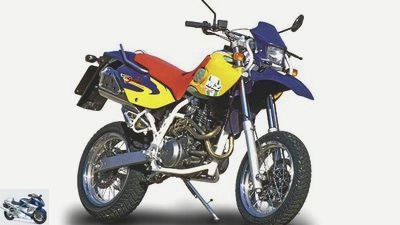
fact
MZ Baghira.
Finally! In 1997, an outcry of relief should have swept through the enduro scene. Until then, the world of Stolltrager either consisted of Osi racers that were only partially suitable for everyday use or snored Far East boredom. In between there was little or nothing, but finally a fresh wind was blowing with the Baghira. The Sachsenkrad offered trendy packaging, an appealing Marzocchi fork and a high-quality White Power shock absorber, a sturdy steel frame with aluminum swing arm and a stainless steel exhaust. On top of that, there was impeccable driving behavior on and, above all, off the road, and the whole thing was also affordable.
So a lot of reason to cheer. But there was no great euphoria, because he of all people was in the frame Yamaha XTZ 660 engine. A nice, very reliable, but also phlegmatic single – the one that was also offered as Street Moto (photo) and built until 2005 MZ would have deserved more. Used from 1800 euros.
plus
- Off-road properties above average, but still fully roadworthy
- Chassis components of high quality, very resilient and beautifully appealing
- Maintenance-friendly construction
minus
- Yamaha engine is reliable, but not very revving and quite tired
- Transmission is annoying now and then with jumping gears
- Footpegs extremely bootlegging
Data
Water-cooled single-cylinder four-stroke engine, 660 cm³, 37 kW (50 PS) at 6500 rpm, weight 174 kg, load 176 kg, tank capacity / reserve 13.5 / 2.5 liters, seat height 920 mm, top speed 157 km / h, consumption (Country road) 4.5 l / 100 km, normal
Suzuki XF 650 Freewind
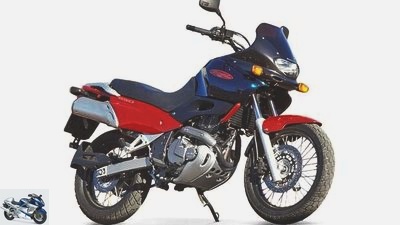
archive
Suzuki XF 650 Freewind.
Who just broke this design? With its sausage, puffy shape, Freewind, which was newly sold from 1997 to 2002, blocked every chance to play more than a minor role in the popular travel enduro middle class. Their inner values are absolutely right. The easy-to-turn four-valve single, which is soft on the bottom and never gives up on the top, is particularly impressive. In addition, a perfectly functioning five-speed gearbox and an extremely comfortable workplace for the driver – Suzi, which is very fairly priced as a new machine, had what it takes to become a bestseller. In addition to the unworthy packaging, only the weak spring elements, especially the cheap shock absorber, spoil the positive image. Especially in pillion operation and / or with more speed
Gait cuts through in front and behind. But you can do something about that with accessories. The funds for this should not be an insurmountable obstacle, because with prices starting at 1300 euros, the reliable Freewind is a very affordable wallflower.
plus
- Powerful engine that reacts spontaneously to gas commands
- Stable, powerful brake
- Gear shifts very precisely
- Driver’s position suitable for long journeys
minus
- Cheap and overwhelmed spring elements
- Passenger seat uncomfortable and too short
- Fork not completely torsion-resistant
- Ground clearance too tight for the terrain
- Processing z. T. a bit coarse
Data
Air / oil-cooled single-cylinder four-stroke engine, 644 cm³, 35 kW (48 PS) at 7000 rpm, weight 188 kg, payload 187 kg, tank capacity 18 liters, seat height 830 mm, top speed 162 km / h, consumption (country road) 5, 5 l / 100 km, normal
Triumph TT 600
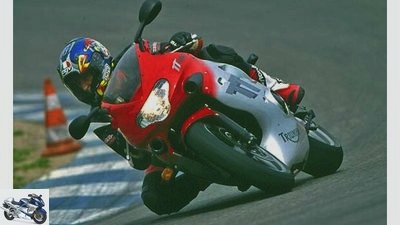
archive
Triumph TT 600.
The career of the TT 600 was not a good star from the start. Ironically, the hard-fought and already top-class 600 super sports class wanted to stir up newcomers Triumph 2000. That went completely wrong, especially in the first model year, the high-revving injection engine – a novelty in this class – had to struggle with massive set-up problems and was rather anemic, especially in the middle speed range. The TT 600 did not come close to the top performance and the fighting weight of the competitors, which did not make things any easier. In terms of design, the newcomer could not set a highlight either – the TT looked like a Honda CBR 600 of the penultimate generation. In terms of the engine, Triumph made major improvements, but the reputation was already permanently ruined. At least in one point, the TT 600 sank the competition from the start: No other chassis could offer a better and more manageable chassis. In 2003 the successor was already ready. To get used from 2000 euros.
plus
- Super stable chassis, neutral
- Steering behavior, excellent handiness
- Brutal acting and finely dosed brakes
- Human-friendly seating position
minus
- Performance characteristics very sharp (especially in the first model year)
- Equipment and workmanship not quite on the level of the competition
- Weight at the upper limit of the class
Data
Water-cooled four-cylinder four-stroke in-line engine, 600 cm³, 80 kW (109 PS) at 12700 rpm, weight 206 kg, payload 189 kg, tank capacity / reserve 17/3 liters, seat height 790 mm, top speed 247 km / h, consumption (country road ) 5.4 l / 100 km, super
Yamaha MT-03
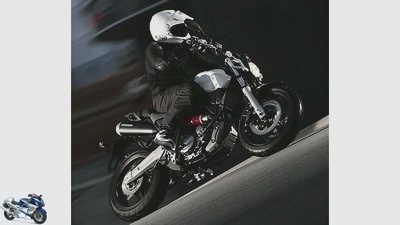
Yamaha MT-03.
Cheeky and fresh packaging, an aggressive and at the same time quite comfortable seating position, a lively engine that almost perfectly implements the single-cylinder ideal of the powerful ballerina, plus crisp handling – what can go wrong in terms of sales? Actually nothing, and yet the one that is still being built is bobbing MT-03 in the approval charts since 2006 under “also ran”. What it has in common with its big sister MT-01, also an all-round successful eye-catcher. Maybe the days of street singles are just over. The Aprilia Pegaso 650, also powered by the water-cooled XT-Single, was already out of the program; the Derbi Mulhacen 659, which is equipped with the same engine, is no longer built and only sold from remnants. But that doesn’t have to burden second-hand buyers any further. On the contrary, if you buy countercyclically now, you will get a well-made road sweeper from 3300 euros.
plus
- Neatly coordinated, powerful and economical engine
- Hearty sound
- Comfortable seating position for the driver
- Inspiring handiness
minus
- Fork a little too soft, shock strut too hard – that causes unrest on mogul slopes
- Front brake requires strong grip for good deceleration
- Light output quite modest
Data
Water-cooled single-cylinder four-stroke engine, 660 cm³, 33 kW (45 PS) at 6000 rpm, weight 194 kg, payload 188 kg, tank capacity / reserve 15 / 4.2 liters, seat height 810 mm, top speed 160 km / h, consumption (country road ) 4.5 l / 100 km, super
Related articles
-
Second-hand advice for beginners 48 hp motorcycles
Horny 21 pictures Horny 1/21 Thanks to the new driving license regulations, entry into the motorcycle world has become even more attractive. And on the…
-
Second-hand advice dream motorcycles
Bilski 15th pictures Gargolov 1/15 Buell XB9 / XB12S / R: from 4500 euros. Gargolov 2/15 Moto Guzzi V11 Sport: from 4000 euros. 3/15 Harley-Davidson Fat…
-
Second-hand advice on Supermoto up to 2,000 euros
fact / Joachim Schahl 15th pictures Jorg Kunstle 1/15 LC4 has been known for KTM since 1994 for Liquid Cooled 4 Stroke, generally recognized as the first…
-
Weird types of used advice – bizarre motorcycles from Japan
jkuenstle.de, Hartmann, Stefan Wolf, markus-jahn.com 9 pictures Rossen Gargolov 1/9 Klaus Herder (54), editor guidebook: Kawasaki VN 1500 Drifter (from…
-
Second-hand advice: winter motorcycles
archive counselor Used purchase Second-hand advice: winter motorcycles Second-hand advice: winter motorcycles Seven bikes for the winter German winters…
-
Second-hand advice: winter bikes for 1500 euros
style-your-garage.com counselor Used purchase Second-hand advice: winter bikes for 1500 euros Second-hand advice on winter bikes for 1500 euros With the…
-
Second-hand advice: 600 athletes up to 3000 euros
fact counselor Used purchase Second-hand advice: 600 athletes up to 3000 euros Second-hand advice: 600 athletes up to 3000 euros 600 from the used…
-
Second-hand advice Tourer for 5000 euros
Sdun counselor Used purchase Second-hand advice Tourer for 5000 euros Second-hand advice Tourer for 5000 euros On the cheap way Motorcycles with built-in…
-
Second-hand advice Italo athletes (price check)
archive counselor Used purchase Second-hand advice Italo athletes (price check) Second-hand advice Italo athletes (price check) Italian for beginners Few…
-
Second-hand advice: desired bikes from the editorial team
AGcuesta – Fotolia 29 pictures AGcuesta – Fotolia 1/29 In private, the MOTORRAD editorial team does not evaluate motorcycles according to standardized…